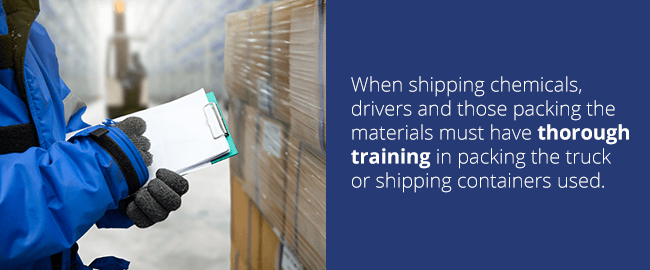The materials used in computer chips and processors require special handling during transport due to their potentially volatile or delicate nature. To ensure the proper flow of goods through the supply chain for electronics, you need to prevent loss by protecting even raw materials from damage. Safely transporting computer materials to electronics manufacturers is essential for meeting the world’s growing demand for computers and other connected devices. As of 2019, there were an estimated 1.33 billion personal computers in use worldwide, not including tablets and other mobile devices. This data clearly shows the ever-growing need for careful handling of the materials used to create such products in these large quantities.
Table of Contents
- What Materials Are in Computer Chips and Processors?
- How to Safely Transport Materials for Computer Processors
- How to Store Computer Chip and Processor Materials
What Materials Are in Computer Chips and Processors?
Computer chips and processors have three materials that contribute to the bulk of their designs — silicon, plastic and copper. Silicon dioxide comes from either silica sand or from quartz. The silicon requires purification. To produce silicon from quartz, producers melt and crystalize the rock. The created crystals are so strong that they require the use of a diamond saw to cut them into thin wafers. Sand requires a similar number of steps to produce the electronic grade silicon ingots.
Typically, these purified cylindrical ingots of silicon are 12 inches across and have a purity of 99.9999%, or one foreign particle per one billion silicon atoms. The wafers or ingots may require storage and transport to get to chip producing factories, which must maintain intensely clean atmospheres to prevent contamination of the chips. In fact, chip production cleanrooms require cleanliness 1,000 times higher than hospital operating rooms.
However, some minerals used in smaller amounts are just as important in the function of the chips and processors. For example, to clean off the silicon wafers and ensure their purity, manufacturers use hydrogen peroxide and sulfuric acid. A rinse of hydrofluoric acid and deionized water follows a pair of baths in these first two chemicals. Lastly, the wafers undergo a final bath in hydrochloric acid, hydrogen peroxide and deionized water.
Other materials and CPU raw materials some manufacturers may use in their computer chips or processors include the following:
- Hafnium: A rare metal used most often in nuclear reactors. It speeds up CPUs.
- Tantalum: Used on GPU transistors along with palladium to increase chip storage space.
- Palladium
- Potassium hydroxide: This chemical, also known as caustic potash, etches a circuit design onto the board.
- Aluminum
- Gold
- Zinc
- Iron
- Nickel
- Copper
These are only some of the numerous materials used in producing computer chips. Some chemicals used during the processing or the precious metals require careful handling due to their dangerous nature or expense. Safe transport and storage of these materials are crucial elements of the supply chain for computer and electronics manufacturers.
How to Safely Transport Materials for Computer Processors
As expected, safely transporting the raw materials needed for computer chips and processors requires caution. The potentially caustic chemicals such as hydrochloric acid and sulfuric acid need to stay isolated to keep them pure and avoid damaging other materials.
Chemical transport often requires temperature control to prevent reactions from occurring with the materials. Depending on where you will ship the chemicals, you may need heated or refrigerated containers. Additionally, some materials may be flammable and need isolation from flames and sparks in explosion-proof containers.
When shipping chemicals, drivers and those packing the materials must have thorough training in packing the truck or shipping containers used. Uneven packing could cause the truck or the contents inside to tip. This happened to a tank trailer that workers unpacked from the rear first, putting too much weight at the front and causing the truck to tip.
Caustic chemicals, like hydrochloric acid, often ship in high concentrations, making them even more dangerous in transit. If left to degrade or packed in containers with reactive materials, these acids could produce toxic gases.
Whenever shipping dangerous substances, carefully train all workers in the proper packaging, loading and handling of the chemicals. Keep every container clearly labeled and ensure you completely fill out the paperwork so everyone along the supply chain knows to use the same care with the containers.
Other materials, like palladium, hafnium and gold need extra security to protect them from theft. Secured containers and shipping conditions ensure these materials reach their destination.
The cut silicon wafers and dies are susceptible to damage from static electricity. When transporting these materials, you need to keep them safe from electrostatic discharge (ESD).
For transport, unsawn wafers remain in boxes while dies stay in waffle packs. Nitrogen fills the bags surrounding either of these products to protect them from external damage or contamination. Sawn wafers lay on adhesive tape that also fit inside nitrogen-filled bags. To ensure the products arrive in good condition, you must keep them protected from temperature extremes and impacts. Temperatures need to stay between 8 degrees Celsius (46.4 degrees Fahrenheit) and 60 degrees Celsius (140 degrees Fahrenheit).
How to Store Computer Chip and Processor Materials
Though many manufacturers order materials on demand to cover gaps in the supply chain, makers such as Texas Instruments, often keep about 90 days of inventory available to fulfill needs. Storage of the materials used for chip and computer processors requires similar conditions as transportation.
Chemicals need careful temperature and environmentally controlled conditions to protect them from spilling or causing damage due to their caustic nature.
You must protect wafers and dies from ESD and temperature extremes. Whether you store the dies and wafers out of their protective nitrogen-filled bags determines the storage conditions. When kept sealed inside their bags, maintain similar temperatures as you would during shipping and a humidity level around 75%.
If you remove wafers or dies from their bags, keep them in a sealed container of nitrogen gas. Humidity must remain between 7% and 30%, and temperatures have a tighter range than for transportation. Keep the inside of these containers between 18 degrees Celsius (64.4 degrees Fahrenheit) and 24 degrees Celsius (75.2 degrees Fahrenheit). Refrigerated container units can help you to keep such a tightly restricted storage environment for either wafers and dies either in their bags or out of their nitrogen-filled transportation bags.
Get Explosion-Proof or Redundant Containers to Protect Your Computer Materials
One way to protect the materials used for computer processors and chips is by keeping and transporting them in an explosion-proof reefer container (when needed for certain chemicals) or using redundant container systems (which have a back-up refrigeration unit to ensure proper temperature maintenance). Single and redundant systems are also available for bulk liquid chemical shipments (known as tank containers).
With substantial amounts of materials needed to meet the growing demand for computers and similar electronic devices, you cannot take chances with damage occurring to the materials used. For more information about our products, such as our container cooling units, tank containers, freezer shipping containers, and pharmaceutical containers, talk to one of our specialists at Klinge Corporation or contact us for a quote.



